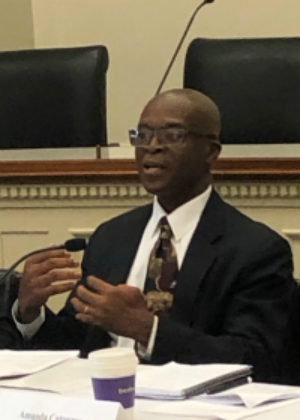Deteriorating security in the Sahel has created tremendous suffering and narrowed the humanitarian space available to respond. This has made operating in the region more complicated and hazardous for relief and development agencies like Lutheran World Relief and IMA World Health, West Africa director Hamid Mansaray told a panel at the recent Capitol Hill launch of the 2020 Global Situation Report published by InterAction.

“Certainly West Africa has the most chronic combination of fragility, insecurity, movement of people (especially youth) from rural to urban areas, weak governance and everything else that comes with that,” he said. “Increasingly it’s becoming difficult to work in certain areas. The space for doing really comprehensive humanitarian and development work is narrowing.”
The rise in conflict in Burkina Faso, Mali and Niger is also highlighted as one of the seven humanitarian hot spots to watch in LWR and IMA’s 2020 Early Warning Forecast, which notes that there was a spike in 2019 with a three-fold increase in violent attacks as extremists purposely inflame existing sectarian and inter-ethnic conflicts. In Burkina Faso alone the displaced have jumped to nearly 500,000 persons. The head of the World Food Program has declared that the region is embroiled in a “three-country crisis" that is causing widespread displacement and hunger.
Mansaray said that Lutheran World Relief and IMA World Health have been able to effectively work in the region by strengthening the capacity of local partners.
“Lutheran World Relief and IMA World Health have built up significant partnerships with many local organizations, with local farmer groups, with local farmer unions. And we’re able to work in these areas, but not necessarily with the overriding presence of a large organization that you usually see in some other cases,” he said.
“And because the capacity of these local organizations has been built up over the years, they themselves now have what it takes to access resources,” he said. “From 2016 to 2021, LWR and IMA will invest over $13 million in building community resilience through these community-based organizations.”
In his closing remarks, Mansaray challenged non-government organizations to ‘be bold’ in diversifying their investments to include impact investing. “Often displaced persons and refugees do not want to return because there are no opportunities to return to. We need to create hope and reasons for the youth to stay in their communities,” he said.
For example, Lutheran World Relief is working in all three countries to build the resilience of farming communities so they can endure both the difficulties of climate shocks, such as prolonged drought, as well as the hardships caused by the effects of violence in and near their communities. As an example of the new normal, Lutheran World Relief has its largest agricultural projects in this region embroiled in conflict, working to help farmers and cooperatives capture significantly more income from local and international value chains. These efforts include a U.S. Department of Agriculture-funded sesame marketing initiative in Burkina Faso, and a large resilience project in Niger funded by the U.S. Agency for International Development and Margaret A. Cargill Philanthropies that leverages public and private sector investments to increase farmer incomes through improved agricultural production and marketing, with a focus on onions, small animals, cowpeas and wheat.
The InterAction report highlights this approach in its section on the Sahel, citing Lutheran World Relief’s Relief to Resilience in the Sahel program, funded by the Bill & Melinda Gates Foundation, that fosters long-term recovery while strengthening local smallholder farmers associations to access climate-smart agricultural technologies and financing.



.jpg.jpeg?itok=K8ShtMPZ)